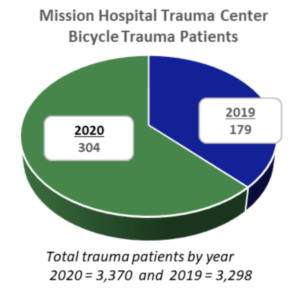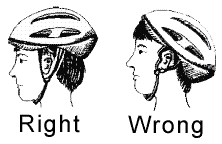Do you remember learning to ride a bike? The feeling of power and speed as your parents let go and realizing you were riding all by yourself? Learning to ride a bicycle has become a rite of passage for children in the United States. It allows kids to begin exploring the world beyond their front yard.
An Increase in Bicycle Sales
Over the past three years, the popularity of e-bikes has made them the cool new way to get around and explore the world outside your neighborhood. When you are too tired to climb that next big hill, you can just switch over to battery power and keep going. An added bonus for parents is less chauffeuring around town. Sounds great, maybe even too good to be true. When things sound too good to be true, they usually are, and local families are learning that the hard way.
Even the Best Preparation
Sarah, a fifteen-year-old high school cheerleader, had been working and saving up her money for months, and she finally had enough in August of 2020 to buy herself an e-bike. She and her parents chose to buy her bike from Brawner’s Boards, a San Clemente surf store that also sells electric beach cruisers. The owners of this family company have strict guidelines for selling e-bikes. They won’t sell them to anybody under the age of fourteen, and they won’t sell them until after they are satisfied that the new owner is able to capably control the bike.
Sarah chose a type one electric beach cruiser, which doesn’t move unless you pedal. It only assists the rider, doesn’t do the work for them.
That isn’t the only training about bike safety that Sarah received. Her mother works in the cycling industry and her father is a captain with the Orange County Fire Department. They made sure she bought a safe bike helmet and knew the rules of the road.
The next day, Sarah rode her new bike to a store less than a mile from her home. The sidewalks are extra-wide on this street, but her parents had emphasized that bikes do not belong on the sidewalk, you have to ride them in the bike lane.
While Sarah was riding home in the bike lane, a car drifted into the bike lane and hit Sarah’s bike from behind. Sarah and her bike were pushed forward. Next, they flipped up onto the windshield of the car and then flew over the back of the car. Sarah landed in the street behind the car. Meanwhile, the driver of the car sped away from the scene. Sarah stood up and somehow walked to the curb and sat down.
A witness called 911 and then Sarah’s mother. They stayed with Sarah until the paramedics arrived. The first paramedic on the scene was Sarah’s father, the OCFD captain. Sarah’s father arrived at the same time as her mom.
Sarah has no memory of any of these events, or much of the time she spent in the hospital afterward. Sarah’s collar bone and pelvis were fractured, and her ankle was also broken. Her body was covered in road rash. She still has glass coming out of her skin a year later. It took months for her bones and tissues to heal and there have been other injuries that have come as a result of pushing herself too hard. There is emotional trauma. Sarah has not ridden a bicycle since. She has become a very cautious driver now that she is sixteen and driving a car.
During the accident, the front license plate became entangled with the bike. The driver abandoned the car, a rental, a mile down the road. There is an ongoing criminal investigation.
More Cyclists = More Traumas
During the pandemic, when most everything was closed, many of us felt trapped at home. Riding bikes seemed like a safe way to be outside and maintain social distancing while getting some exercise and protecting the environment. This explains the radical increase in sales of all types of bikes, with a noticeable spike in e-bike purchases.
Trauma centers in Orange County have reported a significant increase in bicycle and electric bike injuries. Trauma centers are separate from emergency rooms. A “trauma designated patient” indicates a potentially life-threatening injury that requires urgent medical assessment.

Along with the many new cyclists came an increase in trauma injuries as a result of biking accidents. The most significant causes of trauma injuries were inexperience, misuse, and inadequate protection. In South Orange County, Mission Hospital trauma center had a marked increase in serious trauma injuries to cyclists, increasing from five percent in 2019, to nine percent in 2020 (these numbers do not include emergency room visits for other injuries such as broken bones). That is almost double in the number of injuries and clearly indicates a need for community prevention and education. In fact, during the first six months of 2021, Mission Hospital has already treated forty-two e-bike trauma patients. Thirty-six percent of these traumas were to adolescents under the age of seventeen.
What’s causing all of these traumas? Traveling at high speeds, choosing not to wear a helmet, not paying attention, not following basic rules, adding alcohol or drugs while cycling, and not having enough experience using gears and battery power. And, as in Sarah’s case, drivers who were not being careful.
Cycling Safety
Many people think it’s simple to just get on a bike and go. It’s not quite that easy. When selecting any bike, especially an e-bike, first consider: is it the right size for the individual to handle? What is the maximum speed the bike can go? Are the new riders given clear instructions on how to use the gears or turn on the motor? Is there an age limit preference? Did they also purchase protective gear such as helmets, knee and elbow pads? Do they know the rules of the road?
The Department of Motor Vehicles website has a page devoted to safety for cyclists. One of the most important safety tips they list is to wear your helmet!
- Protect yourself and wear a helmet – make sure your helmet is properly fitted and that you are following the manufacturer’s directions. By law, all bicycle riders under the age of eighteen must wear a bicycle helmet when riding on public roads.

The California Bicycle Coalition also lists important points about bicycle safety and laws. They explain that there are different classes of e-bikes. Type one and two (with top assisted speeds of twenty mph) are like regular bikes and can be ridden everywhere bicycles are allowed. Type three, or high-speed electric bikes, are in the same category as mopeds. They may not be used on trails or bike paths unless it is allowed by local governments. It is illegal to ride any type of bicycle on freeways or expressways.
Don’t assume anyone can just jump on and ride across town. It takes practice, familiarity, knowledge of how to switch gears, being aware of your surroundings, knowing the rules, and wearing protective gear to ride on public roads safely.
Make sure you do your own research to protect your children. You can’t go back and change the repercussions that a traumatic injury can cause, not only to a loved one, but to the entire family. By doing the research, educating yourself, and taking the proper precautions, you can help protect your family. Let’s work together to get the word out and get our cycling traumas down to zero!
“Let’s face it – electric bikes are here to stay, so we need to work together as a community to keep everyone safe. Kids are permitted to ride class one and class two e-bikes as long as they wear a helmet, but they are unaware of the actual rules of the road and that they can receive citations for violating those laws i.e., stopping at a stop sign, vehicle/pedestrian right of way, properly signaling before turning, etc. This is all knowledge that comes with obtaining a driver’s license and having behind-the-wheel experience yet, so many kids on e-bikes are ending up in our hospital trauma rooms. My goal is that, by visiting schools, talking to students about bike safety, and hosting community forums to help alleviate the stress everyone is experiencing, the number of avoidable accidents will decline, and everyone can enjoy riding their e-bikes safely.” – Ashley Krotine| School Resource Officer | Laguna Beach Police Department
